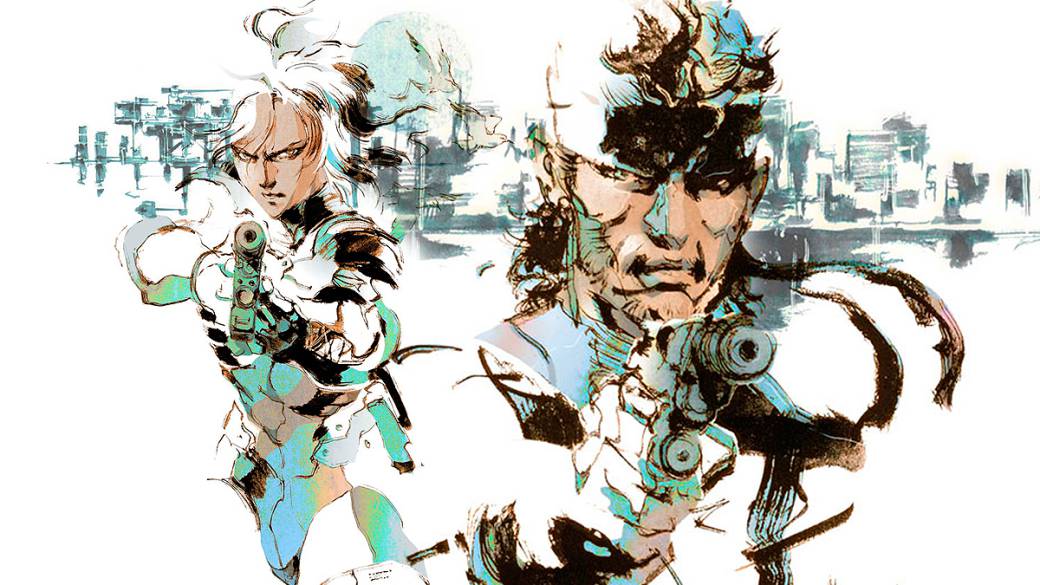
More than fifteen years ago, Metal Gear Solid 2: Sons of Liberty warned us of the dangers of the digital age. We are extremely susceptible to being manipulated.
Metal Gear Solid 2: Sons of Liberty (you can read our review here) was released in 2001. Developed by Konami Computer Entertainment Japan, and distributed by Konami, the sequel to Metal Gear Solid remains, to this day, one of the most divisive titles of the creative Hideo Kojima. In this report we analyze this work at a thematic level, emphasizing postmodernism:
Author’s note: in this report there are guts and spoilers for various titles in the Metal Gear saga, mainly Metal Gear Solid 2: Sons of Liberty. You are warned!
Breaking the charts
Postmodernism, as far as literary works and narrative in general are concerned, could be summarized as an artistic trend in which the works are self-conscious, as they constantly question the conventions of their environment, the nature of the narrative itself, and the characterization of the characters. He constantly plays with the tropes, the topics, and the expectations that the spectator has both about them and about the work itself. Based on this basis, we could consider that Metal Gear Solid 2: Sons of Liberty is a postmodern video game. For many, in fact, it is even the first video game created in this current [1].
After the worldwide success of Metal Gear Solid – managed to sell more than 6 million copies [2]- It was more than sung that both Hideo Kojima and Konami were going to continue with the Metal Gear saga, whatever it was. However, from MGS2 we can deduce, from all the clues that we are given in this work, that Kojima himself was sad about the reception of the previous one. It was a video game with clear anti-war overtones, and in fact this message was heavily influenced. However, many of the players ignored it and did not see further: they stayed in what they considered to be a mere glorification of violence and the classic action hero, despite the fact that MGS also brought with it a good dose of deconstruction of various tropes and conventions of the genre.
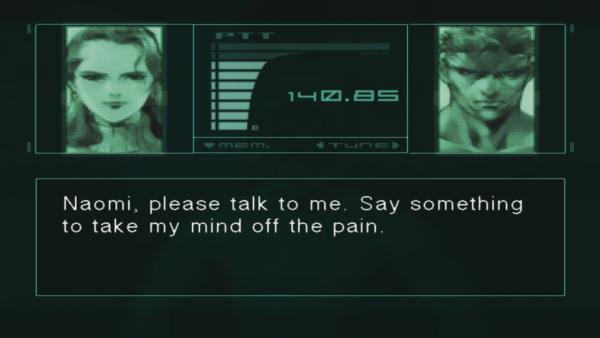
Codec conversation between Naomi Hunter and Solid Snake. Despite his legendary soldier status, Snake is a man broken and haunted by his past.
Meme, gene, scene
It has been long and long talked about that the themes of the first three installments that contain the tagline «Solid» are, respectively, and in English: gene (genes), meme, and scene (scene / context) [3], which in turn make a play on the abbreviation of the saga: MGS. On the other hand, the main theme of Metal Gear Solid 4: Guns of the Patriots is sense; the senses and the experience gained through them. If we go further, the metamessage of these four titles, taken as a tetralogy, is one that is much more oppressive and less obvious: manipulation. This theme is closely linked to another recurrent in the saga: «what are we going to leave for future generations?». In this way, Metal Gear Solid tells us about the manipulation of genes, thanks to which both Solid Snake and Liquid, and the Genome Soldiers were born. Metal Gear Solid 3: Snake Eater tells a story in which there is manipulation of the context and the geopolitical scene, all in pursuit of avoiding nuclear war. Guns of the Patriots presents us with a world in which the manipulation of the senses using nanomachines, virtual reality, and combat supplements, can create soldiers prepared for battle despite having no previous real experience.
Sons of Liberty, meanwhile, contained what is probably the bleakest message of these four titles. The information is, in reality, strictly controlled and manipulated by forces at incomprehensible moments. This information is used as a mechanism for crowd control, coercion, and deception. And, furthermore, how these villains who have been behind the scenes – the Patriots – decide what kind of cultural or behavioral elements – memes – we are able to pass on to future generations, infantilizing ourselves during the process, and believing ourselves with the power to decide for us. His intention could be considered even noble, but his methods are extreme, and they deny any hint of free will on the part of the human being.
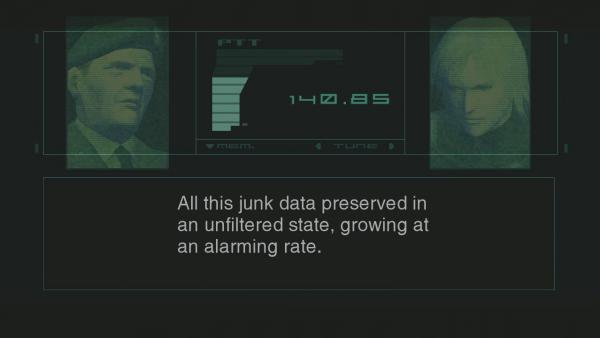
The Patriots plan is to control and manipulate the flow of information according to their interests
The perfect deception
Let’s start from the basis that one of the main messages of Metal Gear Solid 2: Sons of Liberty is the control and manipulation of information because, as ordinary citizens – or users of electronic entertainment – we have demonstrated both actively and passively our inability to extract positive values or messages from everything around us. Instead, we take stories to the letter, questioning their veracity when it is not appropriate, and vice versa. In short: they point to the moon, and we stared at the finger.
Hideo Kojima was well aware of this, which is why he decided to pull off the perfect hoax with Sons of Liberty following the success of MGS. Metal Gear Solid 2 is a self-conscious work in the sense that you know it is a sequel to Metal Gear Solid, and you also know that the player knows that MGS2 is a sequel, which gives him the green light to play as he pleases. with the expectations of the players. Hideo himself stated in an interview the following: [4]
HK: I created the E3 trailer to give everyone an opportunity to imagine what the final game will be like. All rumors could be correct. All rumors could be wrong. One thing is for sure: I think I’ll be able to fool and betray all of you in a pleasant way.
Broadly speaking it would translate as “I have created the trailer – for MGS2 – for E3 to give everyone the opportunity to imagine what the final version of the game will be like. All rumors could be correct. All the rumors could be wrong. But one thing is certain: I think I will be able to cheat and betray you all in a pleasant way. This statement fits with the theory that we propose of the author’s intention regarding his work: to deceive the user deliberately and not with a purpose as crude as mere fraud, but with a didactic purpose; so that your message enters us like a nail. The trailer referenced in the excerpt from a previous interview was the reveal of Metal Gear Solid 2 at E3 in the year 2000, and you can see it below these lines:
In it we see, among other things, a total and complete omission of Raiden – the true protagonist of the game – from the Big Shell plant chapter – where most of the adventure takes place, since the tanker is little more than a prologue -, and the appearance of the FAMAS assault rifle (minute 6:00), a weapon that is not in the final version of the game, but was in Metal Gear Solid. All of this was put there as thoroughly as deliberately to make the players’ minds fill in the gaps. We were shown to Snake, so it was assumed that he was going to be the protagonist again. We were also shown to the sentinels of the game to perform actions not seen in the previous title, so we deduced that the improvement in terms of artificial intelligence, routines and abilities of these characters had been considerable. Bottom line: By deception by omission, the average gamer was led to believe that Sons of Liberty was going to be a sequel to Metal Gear Solid in the strictest sense of the word. In fact, there is only one Yoji Shinkawa art depicting Snake on the game’s cover art, and on the back cover is a selection of screenshots in which there is also no trace of Raiden. No one but the ones involved in the trick could foresee what was really going on.
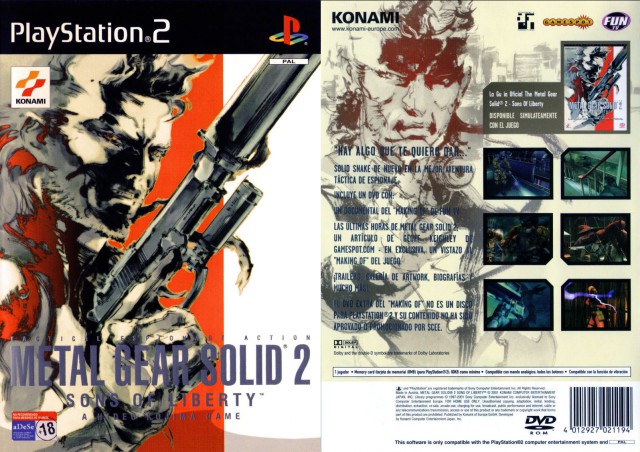
Cover and back cover of Metal Gear Solid 2: Sons of Liberty in Spain
More and better
With the heading above these lines we could summarize quite concisely what we would expect from any self-respecting sequel. After all, if something works, why are you going to change it? This is usually the default thinking when creating a second part of any type of work. However, Kojima is not just any author, and in one of the conversations in the final stretch of Sons of Liberty he drops a pretty clear clue regarding his intention, and how he felt about MGS’s success. Arsenal Gear’s AI, GW, using Colonel Campbell’s avatar, tells Raiden that “as it already happens in genetics, information and memory must be filtered to stimulate the evolution of the species.” In other words, the only way for us to move forward is through new ideas. If we always stay with the same, we do not advance.
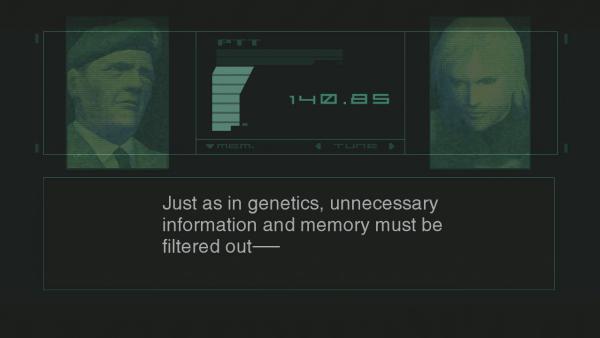
According to the Patriots, “as it happens in genetics, unnecessary information and memories must be filtered”
The playable prologue, the tanker chapter, has little effect on the overall plot of Metal Gear Solid 2 when compared to the plant chapter. In fact, it could have been easily replaced by a series of movie scenes, given its brevity. If we focus on the playable part of Raiden, the similarities with Metal Gear Solid are more than evident. Apart from the fact that, at the beginning of the game, the Colonel refers to Raiden as «Snake» to, shortly after, change his code name. The premise is, broadly speaking, the same: a group of US Army special forces has taken over a facility and barricaded itself, demanding that the government meet a series of demands.
Dead Cell is the FOXHOUND of Sons of Liberty. Even several of its members are an amalgam of the final bosses of MGS, both for the scenario in which we fight against them, as for the number of times, or for the methods that we must use to defeat them. The fight against Fatman is very reminiscent of the Vulcan Raven, since it takes place in a maze of industrial containers, and also one of the most efficient strategies to defeat him is to place Claymore mines. The Harrier is quite reminiscent of Hind D: it is an aircraft that attacks us from all angles, we must shoot it down with Stinger missiles, and it is piloted by one of Solid Snake’s genetic brothers. We faced Vamp twice, as already happened with Sniper Wolf, being in the second encounter, in addition, necessary to use a sniper rifle.
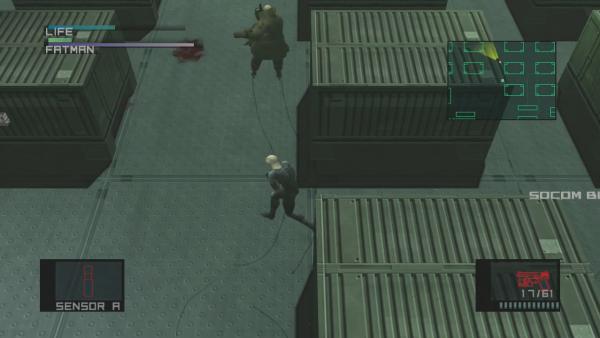
The fight against Fatman in Metal Gear Solid 2 is very reminiscent of the fight against Vulcan Raven in the previous title
As if these references were not clear enough, there is a section in which, handling Raiden, the enemy forces capture us and subject us to torture. Yes, the same happened in Metal Gear Solid. But the funny thing about this specific instance is that the torture room is exactly the same as the one on Shadow Moses Island in the previous title. We understand all these pills – there are many more – as a declaration of intent: it is Kojima’s way of giving fans exactly what they were asking for: a sequel that practically traces the original work point by point. All in order to make the message sink in: we need fresh ideas to avoid stagnation. This is justified by the plot as the Patriots’ S3 Plan: it is initially revealed to us what Solid Snake Simulation means, a trick by which this organization tried to create new Solid Snake by subjecting the military to situations similar to that of Shadow Moses, although Later it is revealed that it is actually Selection for Societal Sanity, a plan with which they simply intend to control the flow of information and even mold specific individuals as they wish by manipulating the context.
Supersoldiers with no real experience
Raiden, the true protagonist of Metal Gear Solid 2, is the player’s avatar on many levels. It is not only the character that controls who is at the controls of the game; it’s also a metaphorical representation of the average fan: awkward, freaked out, and ridiculous. At the beginning of the adventure, from Raiden we knew several curious facts. Among them that he has no real combat experience, but all his training has consisted of overcoming virtual reality (VR) missions, that he has completed a simulation of the Shadow Moses incident, and that he is a Solid Snake fanboy. There is no room for doubt: Raiden is the player. As if that were not enough, practically at the beginning of the chapter of the plant, we must enter our personal data – name, date of birth … – as if it were a role-playing game.
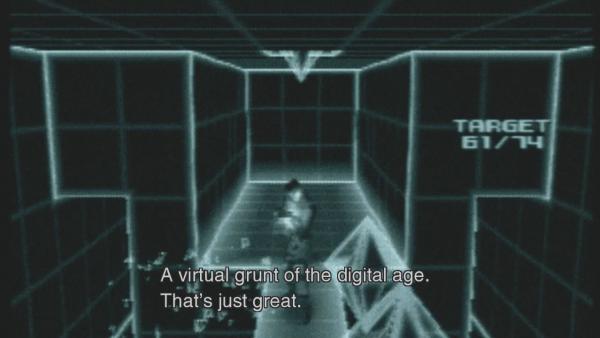
Metal Gear Solid: VR Missions gameplay is shown in one of the game’s sequences talking about Raiden’s combat experience.
Such is the level of comparison, that in several flashbacks in which reference is made to the combat experience that Raiden has obtained through this artificial route, what is shown are video clips of both Metal Gear Solid and several of his VR Missions. Basically, the game tells us that Raiden has passed MGS, and his levels of virtual reality missions, just like the player.
Having established this association, we are going to list some rather curious instances of how the rest of the characters in the game world interact with Raiden and, by extension, with us as players. One of the things that Metal Gear Solid 2 wants to put in our heads at all costs is that we are not Solid Snake, this being a criticism of those who use electronic entertainment as an escape valve, and towards escapism in general. Whenever there is a situation reminiscent of another in MGS in Sons of Liberty, Raiden comes out much worse off than Snake did in what are theoretically the same circumstances. It pales in comparison. No one takes him seriously, and shortly after his combat experience comes up as a topic of conversation, the other characters lack time to tell him he’s a rookie. For example, Fortune, who is the first final boss of the plant chapter, is impossible to defeat. As if that were not enough, he constantly mocks us. Again, this sends us the message for the umpteenth time that we get the idea that we are Snake out of our minds.
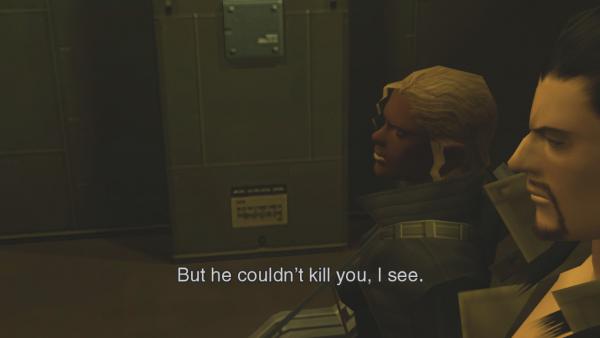
Vamp scoffs at the fact that Raiden – and, by extension, the player – was unable to kill Fortune during their first encounter.
Construction and dissociation of identity
The path to enlightenment that both Raiden and the player go through is full of a series of rather uncomfortable revelations in which, drawing parallels between both parties, it is made known to the two that they are being victims of a deception. The Patriots have duped Raiden based on his previous experience and expectations that he meet a specific goal; It’s not much different than how the average player bought and played Sons of Liberty with the intention of embodying a legendary hero. Or, to be more precise: with the intention of handling Solid Snake.
The playable first-person camera mechanics – seeing the game world through the eyes of the controllable character in it – already existed in the previous title. However, here it gains more relevance, since it becomes necessary to advance, as when we have to deactivate the bombs that are all over Big Shell. In a way, MGS2 deliberately puts us physically and metaphorically inside Raiden, so that we can get used to him and these new circumstances.
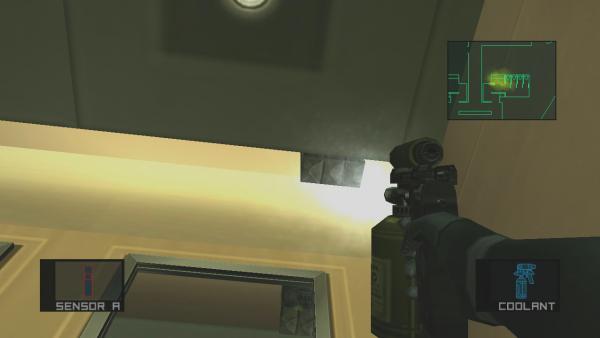
In a section of Metal Gear Solid 2 we must deactivate pumps in the first person by spraying them with coolant
And it is precisely towards the end of Sons of Liberty when the game, again, and to demonstrate something, forces us to leave the interior of Raiden. All this coincides with the construction of an identity by the character: at this point in the plot there have already been several conversations in which it is established that Raiden is not who or what appears to be a priori: he was a child soldier during the Liberian civil war, so he has real combat experience from his childhood, and psychological problems derived from this even more serious than those of Snake himself.
As we say, this instance in which the player avatar is first dissociated is a very specific one: when Raiden gets the katana – named H.F. Blade, “high frequency blade” in Spanish – and fights, side by side with Snake, against the Tengu soldiers inside Arsenal Gear. The katana is a white weapon that we commonly associate today with titles of the hack ‘n slash genre such as Ninja Gaiden, in which it is unthinkable to play in the first person. In fact, the most efficient way to play with her equipped in Sons of Liberty is precisely in the third person, making the player leave Raiden and, at the same time, letting the character use his most deadly weapon and the one with which he is most acquainted. This setpiece is also relatively easily completed using this weapon — despite having the rest of our arsenal of firearms available — so the message seems pretty clear.
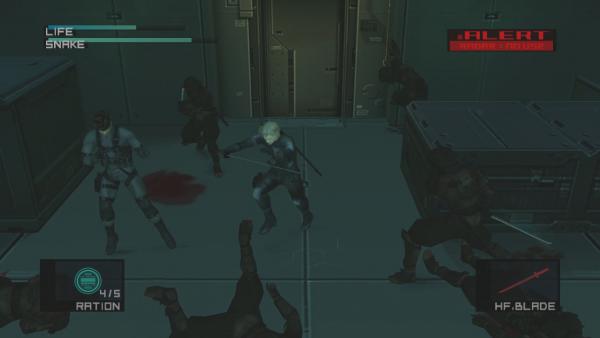
Snake and Raiden confront the Tengu Soldiers in the bowels of Arsenal Gear
However, the final break between Raiden and the player comes at the end of the game. When Snake asks him if he knows the name on his nameplates – in which the common thing is that we have entered ours when thinking that we were in a role-playing game – Raiden responds with that “he has not heard that name in his life “to subsequently launch them into the air, and declare that” he will choose his own name and his own life “. Raiden has finally managed, with the help of Solid Snake, to set out on his own path, and not be a mere tabula rasa that both Patriots and players can manipulate at will.
What’s more: When we have finished watching the final cinematic scenes and return to the title screen, we will see that it has changed. It was previously chaired by a red Solid Snake illustration, while now there is a blue Raiden artwork. The choice of colors is also not a coincidence: the red on the icon in the weapons menu implies that they are of lethal use, while the blue indicates that they are of non-lethal use. This last type of weapon was one of the great novelties of Metal Gear Solid 2, which is why this color has been associated with Raiden. The old has finally ended up giving way to the new, and the game hopes that by now the players have accepted and assumed what they have seen; there is no reason to continue cheating.

Initial ‘Press Start’ screen for Metal Gear Solid 2: Sons of Liberty HD Edition
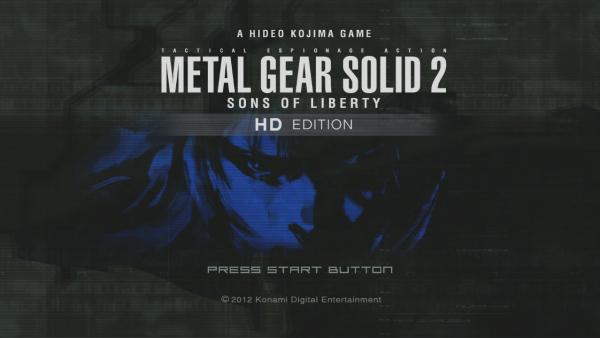
Metal Gear Solid 2: Sons of Liberty HD Edition “Press Start” screen once we complete the game
Reality or fiction?
The plot of Sons of Liberty reached a level of surrealism never before seen in both the saga and this hobby, and that we came from a video game in which there are people with psychic powers, witches, and shamans, and the characters think it is something most mundane. This constant squandering of the reputation built by its predecessor came, in addition, sweetened with a series of clues that —even being discredited later by Guns of the Patriots— implied that, depending on who you asked, the entire chapter of the plant, all Metal Gear Solid 2, or both MGS2 and MGS were fiction. A construct of Raiden’s psyche, or mere virtual reality missions that, for practical purposes, had no relevance whatsoever given their status. This “virtual reality theory” has been one of the most popular with fans for many years. [5], and we understand that Kojima deliberately left clues in the game – for example, that Raiden’s Game Over screen is exactly the same as when we failed a virtual reality mission – precisely to mislead the less savvy and distract their attention from what truly important: the message.
Snake himself says it at the end of the game in a crystalline way: «your memories and the role assigned to you are things that you have to carry. It doesn’t matter if they were real or not; That’s not the point. […] What you think you see is only as real as your brain tells you it is. […] Don’t be obsessed with words. Find the meaning behind them, and then decide.

Snake comforts Raiden at the end of the game, telling him that “it doesn’t matter if (the experiences) have been real or not; that’s not important”
Basically, what happened with Metal Gear Solid 2 was that Kojima had to treat the average player like a kid, all as long as his message was heard. To the moral of MGS – our actions are what determine our destiny, and not our genes – we had to add, in this case, that of Sons of Liberty: we have to try to get something positive out of all the stories we know, whether they are real or not. And, knowing what information and values to transmit to the next generation, since not everything is genes, is how we can ensure we have a prosperous future both at the species and social level.
↑ [1] STANTON, Rich. Metal Gear Solid 2: The first postmodern video game. August 16, 2015, from http://www.eurogamer.net/articles/2015-08-16-metal-gear-solid-2-the-first-postmodern-video-game
↑ [2] Konami press release of May 14, 2003 published on Gameplanet by user Big Gaz on May 15, 2003. From http://www.gameplanet.co.nz/mag.dyn/Features/1751.html, archived at https://web.archive.org/web/20070713084028/http://www.gameplanet.co.nz/mag.dyn/Features/1751.html
↑ [3] Themes in the Metal Gear series. From http://metalgear.wikia.com/wiki/Themes_in_the_Metal_Gear_series
↑ [4] Electronic Gaming Monthly. October 2001, Number # 147
↑ [5] WOLFE, Terry. The VR Theory. From http://metagearsolid.org/reports_vr_theory_2a.html

